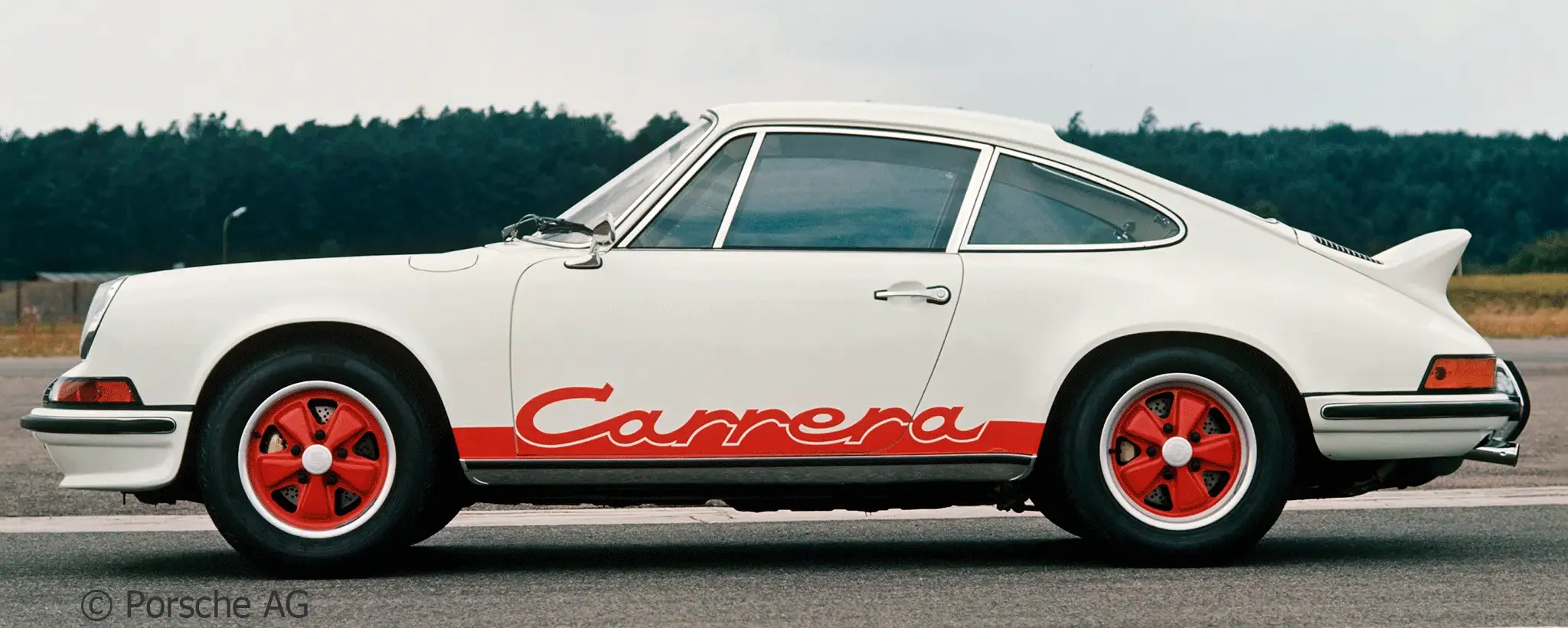

The "Ducktail" turns 50!
It was intended to become a road-legal vehicle for customers who also wanted to participate in racing events. Today, the RS is a true cult classic. The integrated rear wing gave it the nickname "Ducktail" - with it, Porsche established the trend of rear spoilers on production cars in 1972, which, along with the fenders that also flared out at the front, were characteristic of all later Carrera models.
The model designation Carrera of the most powerful type in the Porsche program, which already had a tradition of almost twenty years. Inspired by the remarkable racing successes at the famous Carrera Mexicana, Porsche presented the first Carrera sports car for road use as early as 1955. This was a sporty version of the 356 Coupe, with a 4-cylinder boxer engine with 1500 cm3 displacement and 90 hp output.
It was produced for around six years - in 1960 and 1961 exclusively as a racing car - until the Carrera series was initially ended with the 2-liter Type 356B in March 1963.

Advertisement for Carrera RS as Germany's fastest volume production sports car.
Just under ten years later, Porsche wanted to reactivate the sporty appeal of the attractive name with the Carrera RS 2.7, and this calculation paid off very quickly. The 210 hp bolide was a 911 S whose boxer engine had been enlarged to 2687 cm³ displacement. Plastic and light alloy parts were used to reduce weight - even the engine compartment lid with the integrated rear spoiler was made of plastic. The RS runs on regular gasoline and originally a limited series of 500 units was envisaged with homologation for Group 4 GT racing. By the end of November, all 500 examples had already been sold out. Due to the enormous buying interest, a further 1080 cars were built in the following year 1973, which also allowed them to be used in Group 3. Porsche built 200 of these in the lightweight "Sport" version, with the interior reduced to the essentials, and 55 models in the "RSR" racing version. In addition to the "duck rump," the striking "Carrera" lettering between the wheel cutouts was one of the RS's distinctive features. With a top speed of over 240 km/h and acceleration from 0 to 100 km/h in 5.8 seconds in the sports version, the most powerful model variant of the 911 was able to gain a great deal of respect in sports use within a very short time and advanced to become a sought-after enthusiast's vehicle.
Thanks to its high cornering speed, enormous sprinting ability and extreme maneuverability, the Carrera is perfect on winding interurban roads. The achievable cornering speeds are so high that the car still rolls smoothly in the lane it is in when other vehicles would already be steering out of the bend.
The trade press generally attests to the fact that a few, even considerably more expensive top sports cars may be slightly superior to the Carrera RS in terms of numerical performance. But in the end, none of them is just as economical and suitable for everyday use - or faster and safer on winding roads.

High cornering speed and extreme maneuverability distinguished the Carrera RS.
ZF can be proud to its contribution to this legacy. Porsche and ZF are linked by a very long tradition. So, it is not surprising that the Stuttgart-based company again relied on ZF's rack-and-pinion steering system and self-locking differential for this model. In the trade press, the precise and direct operation of the steering system also scored well.
For the limited-slip differentials, ZF Tradition's historic workshop can provide interested parties with spare parts on a case-by-case basis. If necessary, custom-made parts are also possible. Interested parties should contact ZF Tradition directly.














